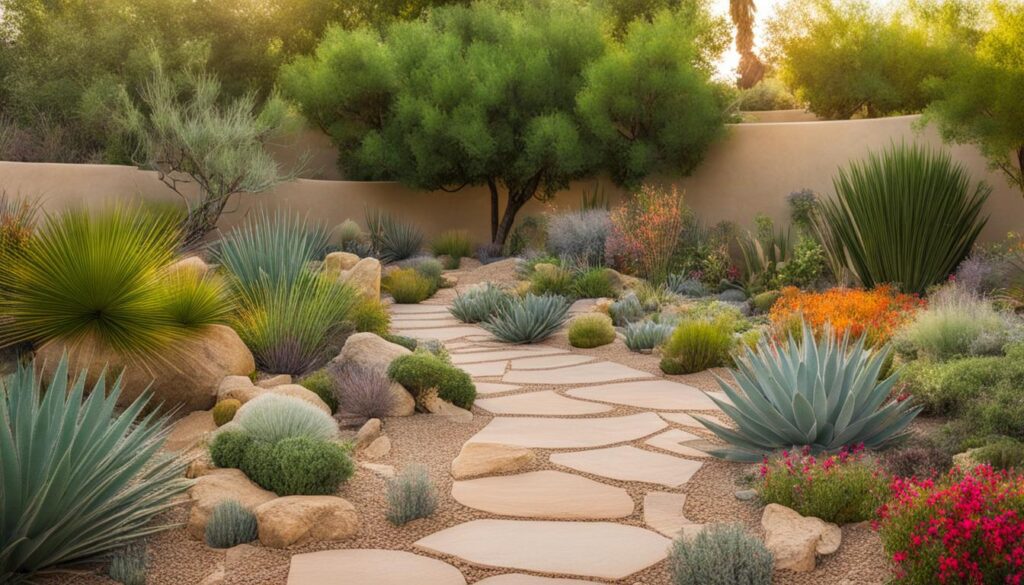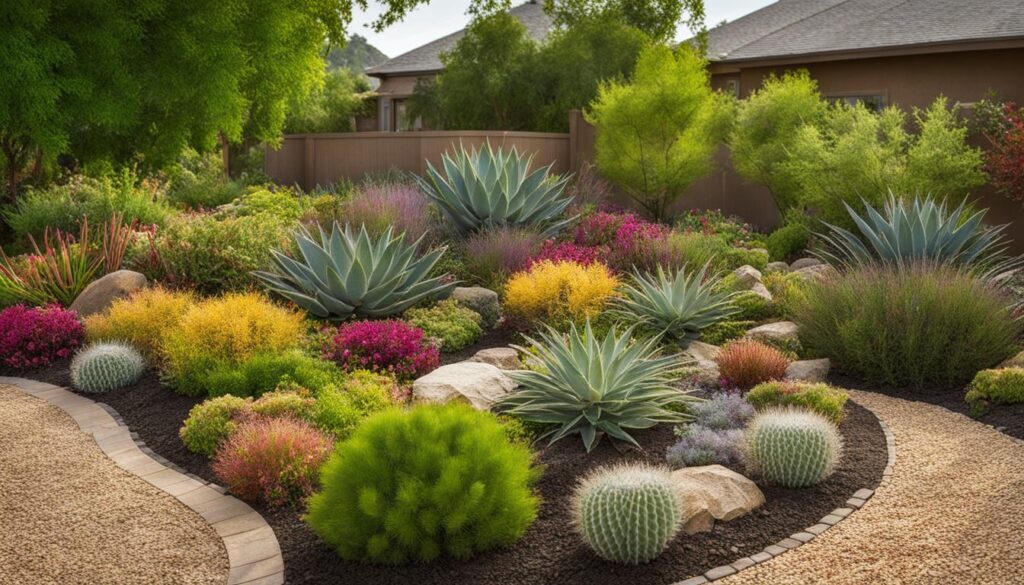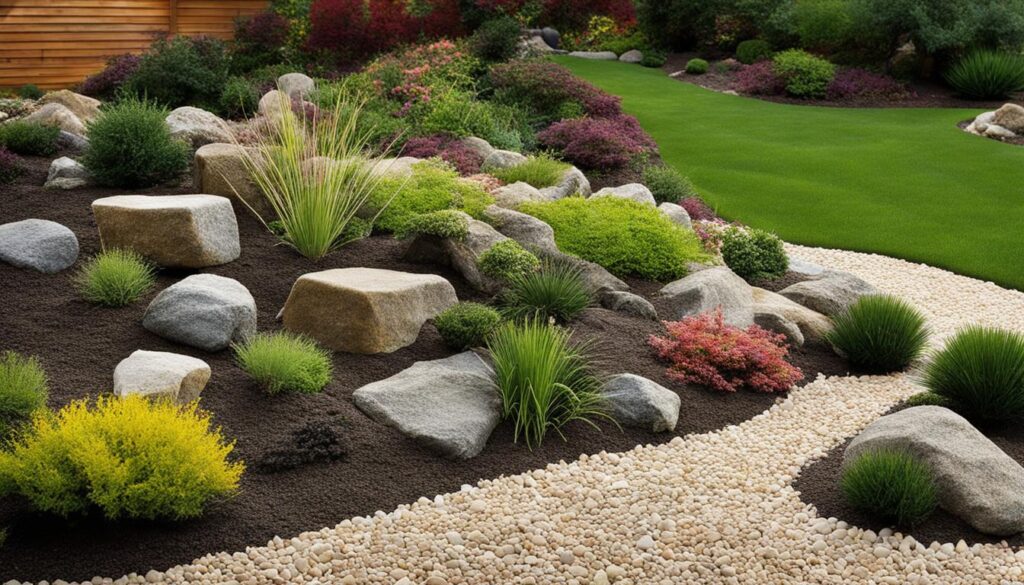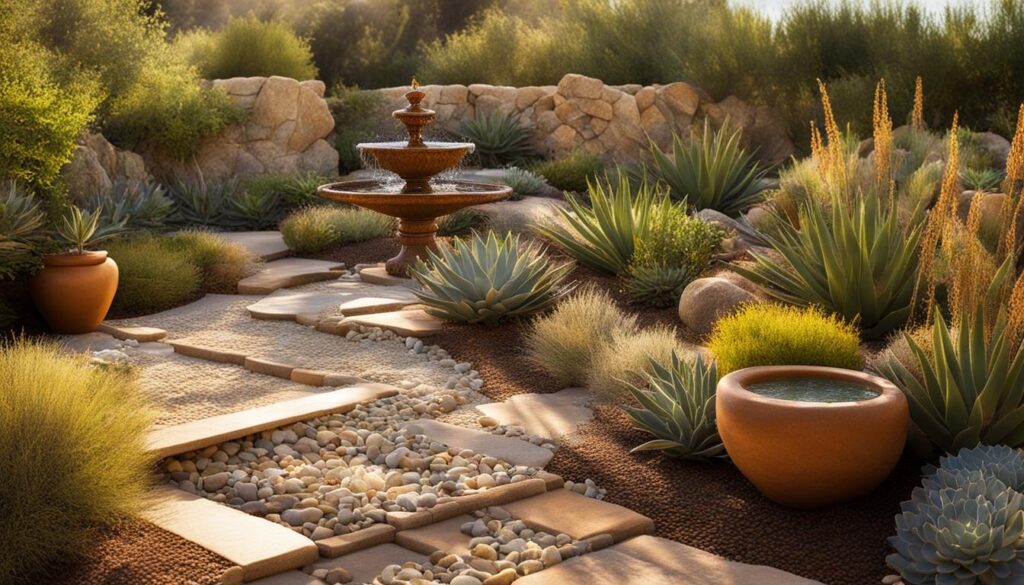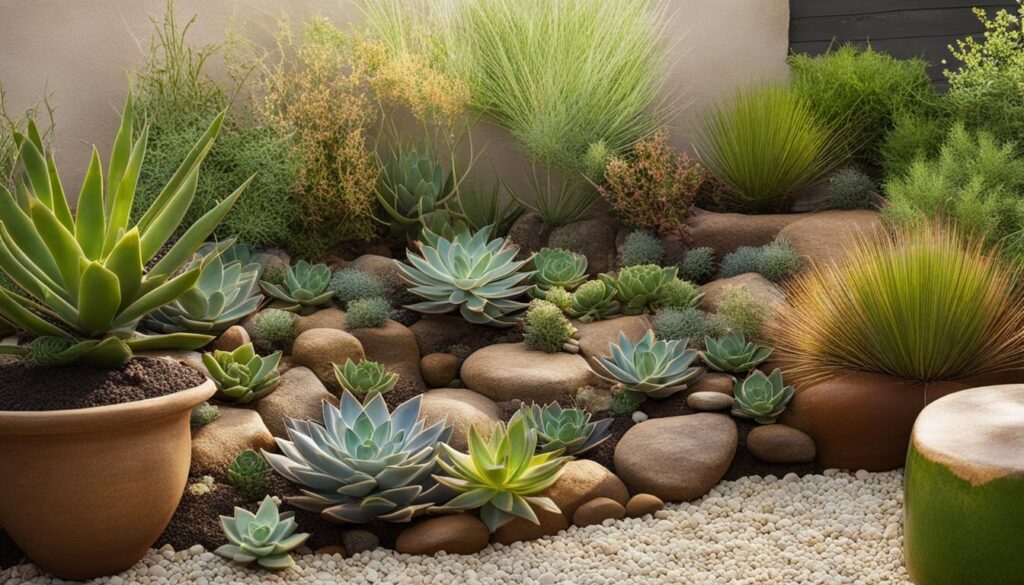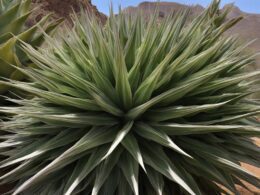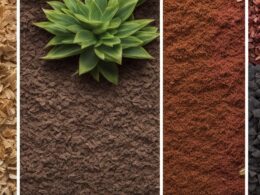Xeriscape landscaping is an excellent choice for creating beautiful and low-maintenance landscapes in dry environments. It involves using native plants, mulch, rocks, and drip irrigation systems to reduce watering needs. With xeriscape layouts, you can transform your small garden into a drought-tolerant and eco-friendly space that requires minimal water and maintenance.
Key Takeaways:
- Implementing xeriscape layouts can create a beautiful and low-maintenance landscape in small gardens.
- Using native plants, mulch, rocks, and drip irrigation systems reduces watering needs.
- Xeriscape layouts are ideal for creating drought-tolerant and eco-friendly yards.
- By incorporating xeriscape principles, you can conserve water and reduce maintenance tasks.
- Transform your small garden into a sustainable oasis with xeriscape landscaping.
Benefits of Xeriscape Landscaping
Xeriscape landscaping offers numerous benefits for small gardens. By implementing this eco-friendly approach, you can not only create a beautiful outdoor space but also enjoy significant savings on water bills and reduce the time and effort spent on maintenance tasks. Here are some key advantages of xeriscape layouts:
- Low water bills: Xeriscape landscaping relies on native plants that are adapted to the local climate and require less water than traditional landscaping. By choosing drought-tolerant plants, you can greatly reduce your water consumption and lower your monthly bills.
- Minimal maintenance: With xeriscape layouts, you can say goodbye to time-consuming and labor-intensive gardening tasks. Native plants are typically low-maintenance, requiring little to no trimming and fertilizing. By reducing the need for constant upkeep, you’ll have more leisure time to enjoy your garden.
- Native plants: One of the core principles of xeriscape landscaping is using native plants. These plants are well-suited to the local climate and soil conditions, making them hardier and more resistant to pests and diseases. Native plants also provide crucial habitat for local wildlife, supporting biodiversity in your garden.
Incorporating xeriscape layouts into your small garden not only benefits you but also the environment. By conserving water and reducing the use of chemicals, you contribute to sustainable and eco-friendly landscaping practices.
By implementing xeriscape landscaping, you can create a beautiful and sustainable garden that not only enhances the aesthetic appeal of your outdoor space but also promotes conservation and reduces your ecological footprint.
Essential Elements of Xeriscape Layouts
Incorporating essential elements into your xeriscape layout is key to creating a beautiful and sustainable garden that requires minimal water and maintenance. Here are some important elements to consider:
1. Mulch for Xeriscape
Mulch plays a crucial role in xeriscape layouts. It helps retain moisture, suppress weed growth, and prevent soil erosion. Choose organic mulch such as wood chips, straw, or shredded bark, which not only conserve water but also enrich the soil as they break down over time. Spread a layer of mulch around your plants, leaving a few inches of space around the base to prevent moisture buildup and potential rot.
2. Alternative to Grass: Groundcovers
Traditional grass lawns require excessive watering to stay lush and green. Instead, consider using groundcovers as an eco-friendly alternative. Groundcovers are low-growing plants that spread quickly, covering the soil and suppressing weed growth. They help conserve water and reduce the need for mowing. Choose native groundcovers like creeping thyme, sedum, or mosses that thrive in your region’s climate and require minimal watering.
3. Garden Paths
Incorporating garden paths into your xeriscape layout not only adds functionality but also enhances the overall aesthetics of your garden. Choose permeable materials like pavers or gravel for your paths to allow rainwater to penetrate the soil rather than causing runoff. Additionally, consider designing curved paths to create a sense of flow and make your garden feel more inviting. You can also use stepping stones surrounded by groundcovers to create a natural and visually appealing pathway.
By incorporating these essential elements into your xeriscape layout, you can create a sustainable and visually appealing garden that thrives in dry environments. Remember to choose native plants, use mulch to conserve moisture, opt for groundcovers as an alternative to grass, and design functional garden paths. These elements will not only reduce your water consumption but also contribute to the overall beauty and longevity of your xeriscape garden.
Incorporating Rocks in Xeriscape Design
One of the key elements in creating a stunning xeriscape design is the strategic use of rocks and boulders. Not only do rocks add visual interest and texture to your landscape, but they also serve important functional purposes. Rocks help prevent evaporation by providing shade and insulation to the soil, reducing water loss. By incorporating rocks into your xeriscape layout, you can create a beautiful and sustainable garden that requires minimal watering and maintenance.
A popular way to incorporate rocks in xeriscape design is by creating rock gardens. These gardens feature a combination of carefully arranged boulders and drought-resistant plants such as cacti, succulents, wildflowers, and herbs. The boulders act as focal points, adding structure and depth to the landscape, while the plants provide color and softness against the rugged backdrop. To create a cascading effect, consider planting creeping ground covers like creeping thyme, lamium, creeping phlox, or campanula that will gracefully spill over the rocks, enhancing the overall visual appeal.
When selecting rocks for your xeriscape design, opt for locally sourced materials that blend seamlessly with the natural surroundings. This not only creates a harmonious look but also helps support the ecosystem by preserving native habitats. Remember to choose rocks that are large enough to make a statement but not overpower the space. To ensure proper drainage and prevent waterlogging, position the rocks strategically, allowing rainwater to flow freely through the gaps. By incorporating rocks in your xeriscape design, you can create a unique and eye-catching landscape that is both water-wise and aesthetically pleasing.
Benefits of Incorporating Rocks in Xeriscape Design:
- Prevents evaporation, reducing water loss
- Provides shade and insulation to the soil
- Creates focal points and adds visual interest
- Adds structure and depth to the landscape
- Blends seamlessly with the natural surroundings
- Supports the preservation of native habitats
- Requires minimal maintenance and watering
Mediterranean-Inspired Xeriscape Design
Incorporating Mediterranean plants in your xeriscape design can add a touch of beauty and fragrance to your garden. The Mediterranean region is known for its diverse plant life, characterized by vibrant colors, aromatic scents, and drought tolerance. By choosing Mediterranean plants for your xeriscape, you can create a visually stunning and water-efficient garden.
Mediterranean plants such as lavender, rosemary, thyme, and oregano are not only aesthetically pleasing but also offer practical benefits. These herbs can be used for culinary purposes, adding flavors to your dishes straight from your garden. Furthermore, their fragrant aroma can create a relaxing and inviting atmosphere in your outdoor space.
Drought-Tolerant Herbs
One of the key features of Mediterranean plants is their ability to thrive in dry and arid conditions. These plants have adapted to survive in regions with limited water availability, making them an excellent choice for xeriscape gardens. The deep root systems of these herbs allow them to access water deep within the soil, reducing their dependence on irrigation.
“Incorporating Mediterranean plants can transform your xeriscape garden into a fragrant oasis, providing a sensory experience that appeals to both sight and smell.”
In addition to their drought tolerance, Mediterranean plants are known for their low water requirements. Once established, they can withstand prolonged periods of drought, requiring minimal watering. This not only conserves water but also reduces maintenance efforts, making it an ideal choice for those looking to create a low-maintenance and eco-friendly garden.
Fragrant Garden
One of the distinct characteristics of Mediterranean plants is their captivating fragrance. As you stroll through your xeriscape garden, the scents of lavender, rosemary, and thyme can transport you to the idyllic landscapes of the Mediterranean region. The aromatic oils released by these plants can have a calming effect and promote a sense of well-being.
Creating a fragrant garden with Mediterranean plants not only brings joy to your senses but also attracts beneficial pollinators such as bees and butterflies. These pollinators play a crucial role in the ecosystem by aiding in the fertilization of plants, contributing to biodiversity, and supporting the overall health of your garden.
- • Incorporate lavender, rosemary, thyme, and oregano in your xeriscape garden
- • Enjoy the aromatic scents and flavors of these drought-tolerant herbs
- • Create a relaxing and inviting atmosphere in your outdoor space
- • Attract beneficial pollinators and contribute to biodiversity
Xeriscaping with Succulents in Containers
One creative way to incorporate succulents into your xeriscape design is through container gardening. Container gardening allows you to add volume, structure, and plant diversity to your outdoor space while keeping water usage to a minimum. Succulent plants, with their ability to store water in their leaves, are perfectly suited for this low-water approach.
When choosing succulents for your containers, opt for varieties such as cacti, agave, aloe, sedum, and crassula. These plants are known for their ability to thrive in arid conditions and require minimal watering. By using terracotta pots, you can ensure proper drainage, preventing waterlogging and promoting healthy growth for your succulents.
Container gardening with succulents not only adds visual interest to your xeriscape design but also offers practical benefits. You can easily move the containers to different locations to experiment with different layouts or provide optimal growing conditions for your plants. Additionally, by grouping containers together, you can create dynamic displays of color, texture, and height.
Benefits of Container Gardening with Succulents:
- Succulents require minimal water, making them ideal for xeriscape designs.
- Container gardening allows for easy experimentation and flexibility in plant placement.
- Terracotta pots promote proper drainage and prevent waterlogging.
- Grouping containers together creates visually appealing displays of color and texture.
- Succulents add volume, structure, and plant diversity to your xeriscape design.
Tips for Successful Container Gardening with Succulents:
- Choose a well-draining potting mix specifically formulated for succulents.
- Place your containers in areas that receive ample sunlight, as succulents thrive in bright light conditions.
- Be mindful of the watering needs of different succulent varieties, as some may require more water than others.
- Consider the mature size of your chosen succulents and ensure that the containers provide adequate space for growth.
- Rotate your containers periodically to ensure even growth and prevent etiolation.
What Are Some Effective Xeriscape Layouts for Small Gardens?
When creating xeriscape design tips for small spaces, consider using drought-tolerant plants like lavender, yucca, and sedum to minimize water usage. Incorporate gravel or mulch to retain moisture and reduce evaporation. Group plants with similar water needs together and cluster containers for a cohesive look.
Conclusion
Xeriscape layouts are the ideal solution for creating beautiful and sustainable gardens in dry environments. By implementing the principles of xeriscaping, you can transform your small garden into an eco-friendly haven that saves water and adds beauty to your outdoor space.
With the use of native plants, mulch, rocks, and efficient irrigation systems, xeriscape landscaping offers a low-maintenance and water-wise solution. By opting for drought-tolerant plants and reducing watering needs, you can create an eco-friendly landscape that not only saves water but also requires minimal maintenance.
Embracing xeriscape layouts in your small garden not only benefits the environment but also provides functionality and aesthetic appeal. By choosing native plants that thrive in your region, you can create a vibrant and diverse garden that attracts beneficial pollinators and adds charm to your outdoor space. Xeriscaping is an excellent choice for those looking to conserve water resources while still enjoying a beautiful and sustainable garden.






